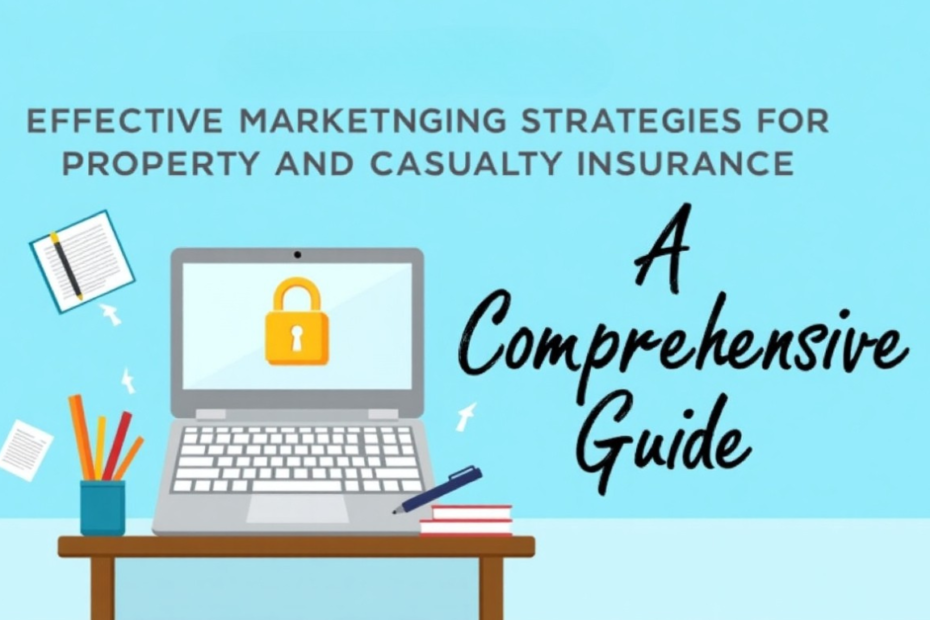I. Understanding the Property and Casualty Insurance Market

A. Overview of Property and Casualty Insurance
Property and Casualty (P&C) insurance protects individuals and businesses from financial losses related to property damage and legal liabilities.
It includes two core components:
- Property Insurance – Covers physical assets like homes, vehicles, and equipment.
- Casualty Insurance – Protects against legal liabilities such as bodily injury and property damage to others.
P&C insurance is critical for both consumers and businesses, providing peace of mind and financial stability when unexpected incidents occur.
B. Current Market Trends
🔹 Changing Consumer Behavior
Today’s customers are digitally empowered, expecting instant quotes, personalized plans, and mobile-first services.
🔹 Technological Shifts
Insurtech innovations like AI-driven underwriting, telematics, and online claims processing are reshaping the landscape.
🔹 Economic Factors
Rising inflation, interest rate fluctuations, and climate-related risks are influencing insurance buying decisions and coverage needs.
C. Regulatory Landscape
Regulatory frameworks vary by region but universally impact pricing, marketing, and disclosure practices.
- State-Level Oversight – In the U.S., regulations are often state-driven.
- Marketing Compliance – Ensures that promotional material is truthful, not misleading, and adheres to privacy laws.
- Fair Disclosure Rules – Insurers must transparently present coverage limitations and exclusions.
II. Identifying Target Audiences
A. Segmentation of the Insurance Market
Successful marketing starts with audience segmentation:
| Segmentation Type | Details |
|---|---|
| Demographic | Age, income, profession, marital status |
| Geographic | Urban vs. rural, regional risk zones |
| Behavioral | Past purchase behavior, risk tolerance, loyalty |
B. Understanding Customer Needs and Preferences
✅ Market Research – Use surveys, focus groups, and data analysis.
✅ Feedback Tools – Online reviews, chatbots, and polls reveal customer pain points.
✅ Customer Profiles – Help predict future behaviors and tailor insurance offerings accordingly.
C. Building Target Personas
Example Personas:
- “Young Urban Renter” – Needs affordable renters’ insurance with digital access.
- “Suburban Family Owner” – Seeks bundled auto + home policies.
- “Small Business Owner” – Requires commercial liability and property coverage.
👉 Each persona needs customized messaging and product alignment for effective conversions.
III. Crafting Effective Marketing Strategies
A. Digital Marketing Approaches
- Website Optimization – Ensure fast load times, mobile responsiveness, and clear CTAs.
- Social Media – Use platforms like Facebook, LinkedIn, and Instagram to educate and engage.
- Email Campaigns – Segment email lists and provide value-driven content.
B. Content Marketing Strategies
📝 Educational Blogs – Break down complex insurance topics into readable posts.
📹 Video Content – Quick explainers and client testimonials perform well on YouTube and TikTok.
📘 Ebooks & Guides – Help build trust and generate leads via gated content.
C. Traditional Marketing Tactics
Old school still works—especially for local engagement:
- Attend local events or sponsor sports teams.
- Build referral networks with realtors, auto dealers, and contractors.
- Distribute targeted direct mail in high-value neighborhoods.
IV. Leveraging Technology in Marketing
A. Utilizing Data Analytics
📊 Track user behavior, quote request patterns, and ad performance.
💡 Tools like Google Analytics and HubSpot provide powerful insights.
🔁 Use these insights to refine content, adjust offers, and personalize follow-ups.
B. Incorporating Automation Tools
Automate repetitive tasks to boost efficiency:
- CRM-Linked Emails – Send birthday offers, policy renewals, or quote follow-ups.
- Chatbots – Engage visitors 24/7 with real-time assistance.
- Social Media Scheduling – Keep posts consistent and timely.
C. Investing in CRM Systems
CRM software helps insurance agents:
- Track leads and policyholders.
- Analyze customer lifetime value.
- Maintain detailed interaction logs.
🔐 Choose a CRM that integrates with email, social, and policy management tools for a seamless workflow.
V. Measuring and Optimizing Marketing Efforts
A. Setting Key Performance Indicators (KPIs)
Examples of KPIs:
| Metric | Why It Matters |
|---|---|
| Conversion Rate | Measures how many visitors become leads/policyholders |
| Customer Acquisition Cost | Helps track marketing budget efficiency |
| Retention Rate | Indicates long-term customer satisfaction |
🎯 Set realistic baselines, and adjust strategy based on performance data.
B. Gathering Customer Feedback
Don’t guess—ask!
- Send post-purchase surveys.
- Use Net Promoter Score (NPS) to assess loyalty.
- Review call logs and support tickets for recurring complaints.
📈 Use this feedback to tweak campaigns and product offerings.
C. Adapting to Market Changes
Stay agile:
- Follow industry news and regulatory updates.
- Monitor your competitors—if they pivot, know why.
- Run A/B tests frequently to stay ahead of consumer behavior shifts.
Conclusion
Property and Casualty insurance marketing isn’t just about flashy ads—it’s about building trust, offering real value, and staying agile in a competitive industry.
From target audience segmentation to technology-driven campaigns, insurers that adopt a comprehensive, customer-first approach will lead the market.
FAQs
Q: What are the primary channels for marketing property and casualty insurance?
A: Digital platforms (social media, email, websites), traditional media (TV, radio, print), and referral networks.
Q: How can small insurance agencies compete with larger firms in marketing?
A: By focusing on local SEO, personalized service, niche targeting, and community engagement.
Q: What role does technology play in modern insurance marketing strategies?
A: It enhances personalization, improves targeting, automates tasks, and provides deep data insights.
Q: How can insurance companies effectively engage with their customers?
A: Through consistent communication, educational content, and by actively listening to feedback.
Q: What are the most effective ways to measure marketing success in insurance?
A: Track KPIs like conversion rates, cost per lead, retention rate, and customer satisfaction scores.
